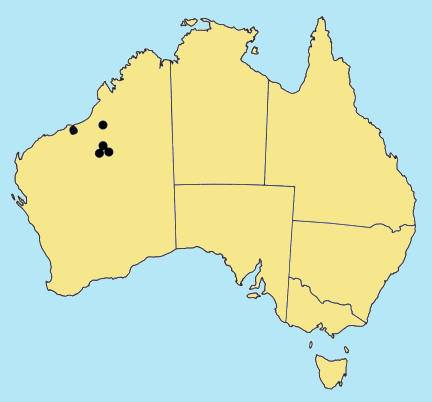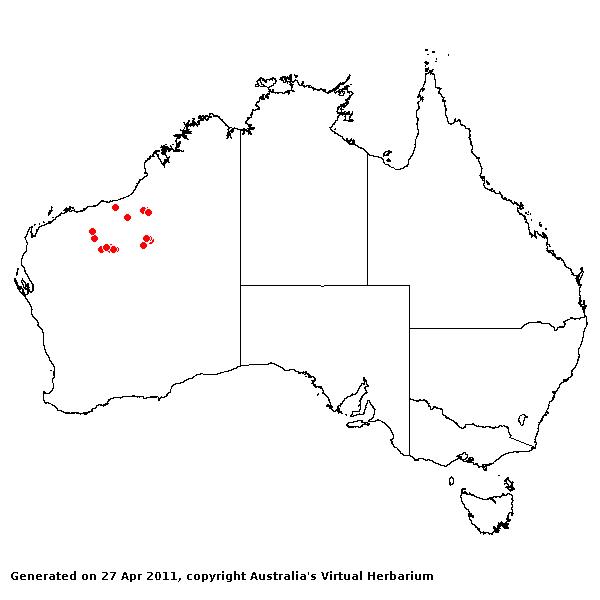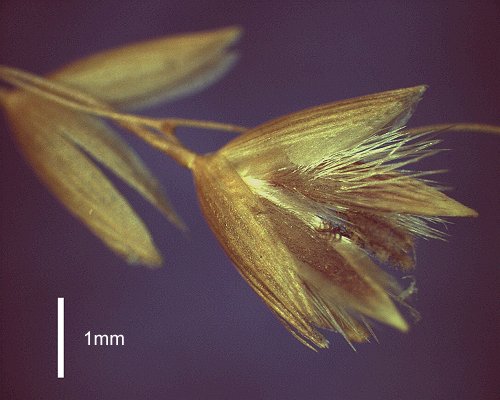Eriachne lanata M. Lazarides. Austral. Syst. Bot. 8: 391 (1995).
Classification. (GPWG 2001) : Subfamily Micrairoideae. Eriachneae.
Type of Basionym or
Protologue Information: Australia, Sahara Track, Telegraph Line: George
9159 (PERTH holo).
Key references
(books and floras): [2002] D.Sharp & B.K.Simon, AusGrass, Grasses of
Australia.
Illustrations:
[2005] K.Mallet (ed.), Flora of Australia 44B: Poaceae 3 (Fig.
25N-O, Fig. 26J-Q).
Habit. Perennial.
Rhizomes absent or present, short. Culms erect or geniculately ascending, 45–60
cm tall, wiry, 4–6 -noded. Mid-culm internodes glabrous or hispid. Mid-culm
nodes glabrous or pubescent or bearded. Lateral branches simple or sparsely
branched or branched. Ligule a fringe of hairs, 0.5–1 mm long. Leaf-blades
curved or flexuous, filiform, conduplicate, 2–3 mm wide. Leaf-blade surface
scabrous, glabrous or indumented.
Inflorescence.
Inflorescence compound, a panicle. Panicle oblong, 6–10 cm long, 2.5–6 cm wide.
Spikelets.
Spikelets pedicelled. Fertile spikelets 2-flowered, both fertile, comprising 2
fertile floret(s), without rachilla extension, ovate, laterally compressed,
3.5–5 mm long.
Glumes.
Glumes similar, thinner than fertile lemma. Lower glume ovate, membranous, much
thinner on margins, without keels, 9–11 -nerved. Lower glume surface glabrous.
Upper glume ovate, 2.6–5 mm long, membranous, without keels, 9–11 -nerved.
Upper glume surface smooth, glabrous.
Florets.
Fertile lemma 3.5–5 mm long, without keel, 5 -nerved. Lemma surface indumented.
Lemma apex muticous. Palea 2 -nerved. Palea apex entire or dentate, muticous.
Lodicules present. Anthers 3. Grain 1.5–2.5 mm long.
Continental
Distribution: Australasia.
Australian
Distribution: Western Australia.
Western Australia:
Canning.
Notes.
The species is distinguished by its perennial compactly tufted habit, thickened
usually woolly base, setaceous curved blades, indumentum of prickly hairs and
tubercles on culms and foliage, open often purple panicle with dichotomous
filiform branches and pedicels, awnless spikelets, glabrous smooth glumes,
narrow florets with appressed lemma and palea, minute bearded subacute callus,
grooveless lemmas with ciliate submargins, entire muticous paleas, and narrowly
ellipsoid compressed caryopsis. A highly distinctive species with apparently
isolated relationships.
Endemic.
W.A. in the Great Sandy Desert. Growing with spinifex (Triodia) on red
sandplains, sometimes in drainage lines, and on rocky hills. Flowers and fruits
Apr.-May (autumn) and July-Aug. (mid-late-winter).



